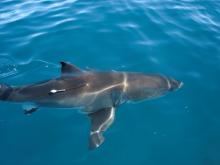Survey Design for Major Pacific Shark Tagging Study Developed by Expert Panel

Information generated by satellite tagging of sharks such as this one provide critical information for management © C. Duffy
January 2017 | Wellington. Accurate estimates of shark mortality in tuna fisheries are critical to proper management. Catch statistics are an important component of the mortality estimate, but there are also sharks which are released alive and subsequently die as a result of trauma and/or stress, which are not counted as catch. With advances in satellite telemetry it has recently become cost-effective to tag and track discarded sharks and determine whether they survive. Such tagging studies provide a valuable new source of information to scientists seeking to refine shark mortality estimates for stock assessments or when evaluating the effectiveness of management measures.
Under the Common Oceans ABNJ Tuna Project, the Western and Central Pacific Fisheries Commission (WCPFC) has been granted $250,000 for electronic tagging of sharks released from longline fisheries. The European Union has contributed another €400,000 to support this effort. The WCPFC and the Pacific Community (SPC) decided to convene an expert panel to ensure the study design would have optimal scientific rigor, cost-effectiveness and consistency with past and ongoing work. The panel, composed of academic, government, and non-government scientists from around the world--representing over 100 years of shark tagging expertise--gathered in Wellington from 24-27 January at New Zealand’s National Institute of Water and Atmospheric Research (NIWA).
The panel started with a series of specialist presentations on WCPFC fisheries, shark physiology, tag types and statistical design issues. Panelists then participated in two half-day roundtables summarizing the key scientific findings and operational lessons learned from all of the major longline and purse seine shark post-release mortality (PRM) studies to date. At that point it was time for the experts to roll-up their sleeves and grapple with the difficult issues of allocating tags to certain species and fisheries, and agreeing the protocols for attaching them, for the WCPFC study. By the close of the meeting, the panel managed to agree a survey design document as well as best practice principles covering equipment selection, statistical stratification and deployment. The meeting report can be downloaded here.
WCPFC and SPC are now preparing to initiate the study following the expert panel’s recommendations. Ideally, and pending permissions, tags will first be attached to shortfin mako sharks by trained and experienced tagging technicians or observers such as those in the New Zealand longline fishery. The intended plan is to then transition the operations to Fiji, home to one of the region’s largest longline fleets catching both shortfin mako and silky sharks. As it is expected that the Fiji fleet may not be representative of the larger freezer longliners operating in the equatorial region, another national observer programme which can serve as a proxy for those vessels, such as the Federated States of Micronesia or the Republic of the Marshall Islands, will also be engaged later in the study. Tags that cannot be deployed in these fisheries may be offered to an ongoing United States government programme tagging oceanic whitetip sharks in American Samoa.
The Common Oceans ABNJ Tuna Project is funded by the Global Environment Facility (GEF) with the Food and Agriculture Organization of the United Nations (FAO) as the implementing agency. This Project harnesses the efforts of a large and diverse array of partners, including the five tuna Regional Fisheries Management Organizations (RFMOs), governments, inter-governmental organizations, non-governmental organizations and private sector to achieve responsible, efficient and sustainable tuna production and biodiversity conservation.

